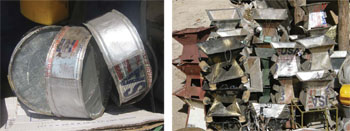Recovery strategies: recycling, composting and energy
Recycling
Recycling is a process by which waste is processed in some way to be reformed into new or similar products. The principle is to make a usable product from the waste. Plastic bottles, newspapers, cardboard and tin cans can all be reprocessed and made into new items. Plastic bags can also be recycled and used to make mats, carpets and other products. Waste metal has a number of possible uses because it is relatively easy to reshape. Careful separation of the waste into its different types is important for the efficiency of recycling processes. Recycling not only reduces the quantity of waste but also saves money, so there is an economic, as well as an environmental, incentive to recycle.

Composting of organic solid wastes
Non-hazardous, putrescible solid wastes such as crop residues, leaves, grass and animal manures can be managed onsite by composting. Composting is a controlled process in which this type of waste is collected in an open pit or heap and is decomposed by natural biological processes. The waste is broken down by the action of a variety of microscopic and other small organisms. The waste is converted into a stabilised material that can be used as fertiliser. Composting is an environmentally friendly way of recovering value from organic waste.
As we discussed in previous sessions, both human waste and organic household waste can be composted. However, the process is different. Human waste can be composted in alternating double pit latrines and in ecological sanitation systems. This process of composting is anaerobic. In the case of organic household waste composting, it is an aerobic process.
What is the difference between aerobic and anaerobic processes?
Aerobic processes require oxygen or air to be present. Anaerobic processes take place without oxygen.
The pit for composting should be dug about 50 m away from a dwelling. The pit needs to be about 1 m deep and at least 1 m breadth and 1 m length. However, the size can vary with the amount of waste generated. The pit depth should be slightly less on one side, about 90 cm, to make a slope so that water does not collect at the bottom. To make the compost, organic matter such as grass, leaves and kitchen/food waste should be thrown into the pit in a shallow layer. It is very important that only biodegradable material is added, so care is needed to sort the waste beforehand. No plastic should be included and bones should be avoided. The waste should then be covered with a thin layer of soil. Covering with soil encourages the composting process and prevents the breeding of flies and other vermin. Air must be allowed to mix with the compost so the contents of the pit need to be turned frequently by digging. The compost needs a small amount of water to keep it moist. The time for the compost to be ready will vary depending on the temperature and the mix of waste among other factors but it should be ready within a few months.
Composting is mostly practised in rural communities, it is becoming customary for households to prepare compost from their household organic wastes and you should encourage this practice.
Energy from incineration
To incinerate something is to burn it. In waste management terms, however, incineration means burning in a controlled and managed process – usually at high temperature. Incineration cannot be implemented at household level; it is mostly used for institutional waste management purposes.
Different types of incinerator are used for burning waste. They differ by the temperature at which they operate, the cost of construction, the method of operation and the maintenance requirement. Incinerators can be used for disposal of wastes in health institutions/facilities and government and private institutions/offices/industries. Incineration can reduce the volume of refuse by up to 90%; the only remaining residual waste is ash. This significantly reduces the volume of material needing final disposal. Incineration is only classed as ‘recovery' in waste management if the energy (heat) that is produced is used in some way.